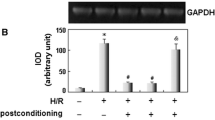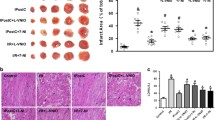Abstract
Objective
Postconditioning protects the heart against ischemia/reperfusion injury by inhibiting cardiomyocyte apoptosis. However, the molecular mechanism by which postconditioning suppresses apoptosis remains to be fully understood. Apoptosis repressor with caspase recruitment domain (ARC) has been demonstrated to possess the ability to protect cardiomyocytes from apoptosis induced by ischemia/reperfusion. It is not yet clear as to whether ARC contributes to the inhibitory effect of postconditioning against cardiomyocyte apoptosis.
Methods
The cultured cardiomyocytes from 1-day old male Sprague–Dawley rats were exposed to 3 h hypoxia followed by 3 h of reoxygenation. Cells were postconditioned by three cycles each of 5 min reoxygenation and 5 min hypoxia before 3 h of reoxygenation.
Results
Hypoxia/reoxygenation led to a decrease of endogenous ARC protein levels. In contrast, postconditioning could block the reduction of endogenous ARC protein levels. Interestingly, inhibition of endogenous ARC expression by ARC antisense oligodeoxynucleotides reduced the inhibitory effect of postconditioning against apoptosis. Furthermore, our data showed that postconditioning suppressed the loss of mitochondrial membrane potential, Bax activation and the release of mitochondrial cytochrome c to cytosol. However, these inhibitory effects of postconditioning disappeared upon knockdown of endogenous ARC.
Conclusion
Our data for the first time demonstrate that ARC plays an essential role in mediating the cardioprotective effect of postconditioning against apoptosis initiated by the mitochondrial pathway.





Similar content being viewed by others
References
Braunwald E, Kloner RA (1985) Myocardial reperfusion: a double-edged sword? J Clin Invest 76:1713–1719. doi:10.1172/JCI112160
Diaz RJ, Wilson GJ (2004) Modifying the first minute of reperfusion: potential for myocardial salvage. Cardiovasc Res 62:4–6. doi:10.1016/j.cardiores.2004.01.036
Zhao ZQ, Corvera JS, Halkos ME et al (2003) Inhibition of myocardial injury by ischemic postconditioning during reperfusion: comparison with ischemic preconditioning. Am J Physiol Heart Circ Physiol 285:579–588
Kin H, Zhao ZQ, Sun HY et al (2004) Postconditioning attenuates myocardial ischemia–reperfusion injury by inhibiting events in the early minutes of reperfusion. Cardiovasc Res 62:74–85. doi:10.1016/j.cardiores.2004.01.006
Sun HY, Wang NP, Kerendi F et al (2005) Hypoxic postconditioning reduces cardiomyocyte loss by inhibiting ROS generation and intracellular Ca2+ overload. Am J Physiol Heart Circ Physiol 288:1900–1908. doi:10.1152/ajpheart.01244.2003
Sun HY, Wang NP, Halkos M et al (2006) Postconditioning attenuates cardiomyocyte apoptosis via inhibition of JNK and p38 mitogen-activated protein kinase signaling pathways. Apoptosis 11:1583–1593. doi:10.1007/s10495-006-9037-8
Wang HC, Zhang HF, Guo WY et al (2006) Hypoxic postconditioning enhances the survival and inhibits apoptosis of cardiomyocytes following reoxygenation: role of peroxynitrite formation. Apoptosis 11:1453–1460. doi:10.1007/s10495-006-7786-z
Weihrauch D, Krolikowski JG, Bienengraeber M et al (2005) Morphine enhances isoflurane-induced postconditioning against myocardial infarction: the role of phosphatidylinositol-3-kinase and opioid receptors in rabbits. Anesth Analg 101(4):942–949. doi:10.1213/01.ane.0000171931.08371.a2
Koseki T, Inohara N, Chen S et al (1998) ARC, an inhibitor of apoptosis expressed in skeletal muscle and heart that interacts selectively with caspases. Proc Natl Acad Sci USA 95:5156–5160. doi:10.1073/pnas.95.9.5156
Nam YJ, Mani K, Ashton AW, Peng CF, Krishnamurthy B, Hayakawa Y, Lee P, Korsmeyer SJ, Kitsis RN (2004) Inhibition of both the extrinsic and intrinsic death pathways through nonhomotypic death-fold interactions. Mol Cell 15:901–912. doi:10.1016/j.molcel.2004.08.020
Ekhterae D, Lin Z, Lundberg MS et al (1999) ARC inhibits cytochrome c release from mitochondria and protects against hypoxia-induced apoptosis in heart-derived H9c2 cells. Circ Res 85:70–77
Gustafsson AB, Sayen MR, Williams SD et al (2002) TAT protein transduction into isolated perfused hearts, TAT-apoptosis repressor with caspase recruitment domain is cardioprotective. Circulation 106:735–739
Jo DG, Jun JI, Chang JW, Hong YM, Song S, Cho DH, Shim SM, Lee HJ, Cho C, Kim do K, Jung YK (2004) Calcium binding of ARC mediates regulation of caspase 8 and cell death. Mol Cell Biol 24:9763–9770. doi:10.1128/MCB.24.22.9763-9770.2004
Pyol JO, Nah J, Kim HJ et al (2008) Protection of cardiomyocytes from ischemia/hypoxic cel death via Drbp1 and pMe2GlyDH in cardio-specific ARC transgenic mice. J Biol Chem 283:30707–30714
Donath S, Li P, Willenbockel C et al (2006) Apoptosis repressor with caspase recruitment domain is required for cardioprotection in response to biomechanical and ischemic stress. Circulation 113:1203–1212. doi:10.1161/CIRCULATIONAHA.105.576785
Argaud L, Gateau-Roesch O, Raisky O et al (2005) Postconditioning inhibits mitochondrial permeability transition. Circulation 111:194–197. doi:10.1161/01.CIR.0000151290.04952.3B
Neuss M, Monticone R, Lundberg MS et al (2001) The apoptotic regulatory protein ARC (apoptosis repressor with caspase recruitment domain) prevents oxidant stress-mediated cell death by preserving mitochondrial function. J Biol Chem 276:33915–33922. doi:10.1074/jbc.M104080200
Li YZ, Liu XH, Zhu XM et al (2007) ARC contributes to the inhibitory effect of preconditioning on cardiomyocyte apoptosis. Apoptosis 12(9):1589–1595. doi:10.1007/s10495-007-0094-4
Salvioli S, Ardizzoni A, Franceschi C et al (1997) JC-1, but not DiOC6(3) or rhodamine 123, is a reliable fluorescent probe to assess delta psi changes in intact cells: implications for studies on mitochondrial functionality during apoptosis. FEBS Lett 411:77–82. doi:10.1016/S0014-5793(97)00669-8
Desagher S, Osen-Sand A, Nichols A et al (1999) Bid-induced conformational change of Bax is responsible for mitochondrial cytochrome c release during apoptosis. J Cell Biol 144(5):891–901. doi:10.1083/jcb.144.5.891
Gustafsson AB, Tsai JG, Logue SE et al (2004) Apoptosis repressor with caspase recruitment domain protects against cell death by interfering with Bax activation. J Biol Chem 279(20):21233–21238. doi:10.1074/jbc.M400695200
Tsang A, Hausenloy DJ, Mocanu MM et al (2004) Postconditioning: a form of “modified reperfusion” protects the myocardium by activating the phosphatidylinositol 3-kinase-Akt pathway. Circ Res 95:230–232. doi:10.1161/01.RES.0000138303.76488.fe
Uchiyama T, Engelman RM, Maulik N et al (2004) Role of Akt signaling in mitochondrial survival pathway triggered by hypoxic preconditioning. Circulation 109:3042–3049. doi:10.1161/01.CIR.0000130647.29030.90
Csonka C, Csont T, Onody A et al (2001) Preconditioning decreases ischemia/reperfusion-induced peroxynitrite formation. Biochem Biophys Res Commun 285(5):1217–1219. doi:10.1006/bbrc.2001.5308
Vinten-Johansen J, Zhao ZQ, Zatta AJ et al (2005) Postconditioning: a new link in nature’s armor against myocardial ischemia–reperfusion injury. Basic Res Cardiol 100:295–310. doi:10.1007/s00395-005-0523-x
Yang XM, Proctor JB, Cui L et al (2004) Multiple, brief coronary occlusions during early reperfusion protect rabbit hearts by targeting cell signaling pathways. J Am Coll Cardiol 44:1103–1110. doi:10.1016/j.jacc.2004.05.060
Kim SO, Baines CP, Critz SD et al (1999) Ischemia induced activation of heat shock protein 27 kinases and casein kinase 2 in the preconditioned rabbit heart. Biochem Cell Biol Biochim Biol Cell 77:559–567. doi:10.1139/bcb-77-6-559
Huang DC, Strasser A (2000) BH3-only proteins-essential initiators of apoptotic cell death. Cell 103:839–842. doi:10.1016/S0092-8674(00)00187-2
Nam YJ, Mani K, Ashton AW et al (2004) Inhibition of both the extrinsic and intrinsic death pathways through nonhomotypic death-fold interactions. Mol Cell 15(6):901–912. doi:10.1016/j.molcel.2004.08.020
Li YZ, Lu DY, Tan WQ et al (2008) p53 initiates apoptosis by transcriptionally targeting the antiapoptotic protein ARC. Mol Cell Biol 28(2):564–574. doi:10.1128/MCB.00738-07
Nam YJ, Mani K, Wu L et al (2007) The apoptosis inhibitor ARC undergoes ubiquitin-proteasomal-mediated degradation in response to death stimuli. J Biol Chem 282:5522–5528. doi:10.1074/jbc.M609186200
Acknowledgments
This work was supported by grants from Chinese National Natural Scientific Fund (Li30570735, Li30772297); National Basic Research Program of China (Liu2007CB512003).
Author information
Authors and Affiliations
Corresponding author
Rights and permissions
About this article
Cite this article
Li, Y., Ge, X. & Liu, X. The cardioprotective effect of postconditioning is mediated by ARC through inhibiting mitochondrial apoptotic pathway. Apoptosis 14, 164–172 (2009). https://doi.org/10.1007/s10495-008-0296-4
Published:
Issue Date:
DOI: https://doi.org/10.1007/s10495-008-0296-4




